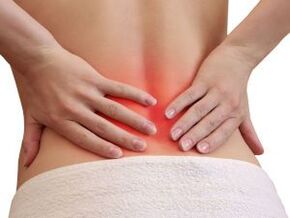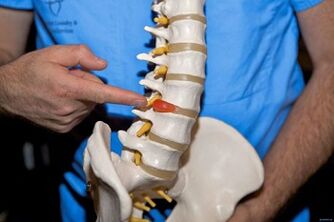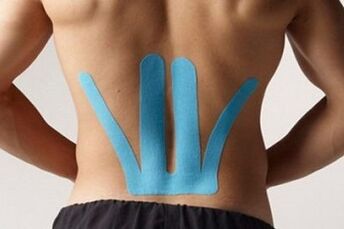
Most people of mainly middle and older and older are faced with back pain in the back of the lower back, and both men and women suffer equally.Pain can occur after physical activity, hypothermia, lifting and carrying severity or due to a long stay in a stationary pose.“Entered the back,” the lower back pain in the lower back is characterized.
Reasons
It should be noted that the pain of different intensities is mostly experienced by people of active age, who are no more than 60 years.This is explained by the constant work of the muscles that support the spine and its natural bends.Since a person is most often in an upright position, the muscles almost do not rest.
The vulnerability of the lumbar region is due to the presence of its weaknesses: the triangle of the bird and the quadrangle (rhombus) Grunfeld-Lesgaft.The poultry triangle has a mild muscle layer and is a small gap between the terminal edges of the wide and external oblique muscle.The Grunfeld-Lesgft rhombus does not close the oblique abdominal muscles on top, it is poorly fortified, therefore it is subject to the formation of lumbar hernias.
The lumbar muscle is the deepest in the body.It affects the flexibility, strength, amplitude of movements and joint mobility, the work of internal organs.It is this muscle that is responsible for maintaining the vertical position of a person and takes an active part in lifting the legs when walking.
Proper operation of the lumbar muscle provides support for the entire upper body and forms a platform for the internal organs of the abdominal cavity.With frequent reduction due to stress or overvoltage, this muscle begins to shorten, which can lead to lower back pain, compression of the nerve endings, deformation of the vertebrae and the development of degenerative processes in the joints.The chronic spasm of the lumbar muscle extremely negatively affects posture, the depth of breathing and the condition of vital organs.
Back pain like a symptom
The lower back can hurt due to problems with the spine or against the background of systemic diseases.Several forms of pain syndrome are clinically distinguished: local, projection, reflected, roying (radicular) and due to muscle spasm.
Local pain syndrome in the lumbar region is constant, its intensity depends on the position of the body.In addition, pain is enhanced by the movements and palpation of a particular area.With this form of pain, mobility of the body and lower extremities may be limited.
The projection pain syndrome is due to damage to the vertebrates and paravertebral (periporteous) structures.It can be spilled or local and occurs due to compression of the nerve endings, which transmit signals to the corresponding area of the brain.Pain sensations are spread along the affected nerve and increase with turns and tilts of the body.During hard work or physical exercises, pulsating pain is noted, the origin of which is associated with an axial load on the spinal column.
The rooser pain syndrome is surprising and pronounced intensity: the patients mean it when they say that the back was “grabbed”.The pain is so acute that a person cannot straighten up and is often forced to remain in the position in which he was overtaken by a roying fire.
In the absence of movements, the roying pain syndrome also does not pass and acquires a aching character.However, attempts to move are accompanied by the strongest cramps and sharp, burning bastards.In the vast majority of cases, it shoots not only at the bottom of the back, but throughout the leg to the ankle.Distinctive features of radicular pain are its strengthening when turning to one side, inclinations and lifting straight legs from the position of lying down.
The reflected pain syndrome indicates the lesion of internal organs.This is due to the fact that the lumbar spine and tissue near the pathological focus are innervated by the same nerve.Since the pain goes from the inside of the body to the surface of the back, the pain is fuzzy, blurry, remains during movements and does not intensify when pressed.
The pain in the lower back can be acute and chronic.If this symptom bothers no more than three months, they talk about acute form.If during this time damaged tissues are not restored, it goes into the category of chronic.
Classification
The lower back pain is classified according to the mechanism of occurrence and can be nociceptive, neuropathic and psychogenic.The nociceptive type appears with irritation of pain receptors - nociceptors and is due to damage to tissues due to mechanical trauma or local inflammation (stretching, bruis).

A hernia is one of the consequences of osteochondrosis, it is manifested by a protrusion of the intervertebral disc between the bodies of the vertebrae.
Neuropathic pains accompany the pinching of nerve roots of intervertebral hernia.They are distinguished by irradiation (return) in the lower limbs and are combined with numbness and some constraint of movements.Such a pain does not pass on its own and is usually chronic.
A psychogenic type is a rare phenomenon, the cause of which can be a traumatic situation or violation of the functioning of the nervous system.
This classification is conditional, since most often soreness cause all three types to one degree or another.To determine pain, doctors use several terms: lumbago, lumbalia and lumbar -algia.
Lumbago is a sudden pain attack, the beginning of which patients describe as “gap”, “push” and compare it with a lightning or electric current blow.Lumbalgia begins gradually and is characterized by aching pains mainly at the bottom of the lower back, at the end of the spine.
In lumbalia, the back does not constantly hurt, pain arises after a long stay in a stationary position or tilting of the body.It is difficult for patients to bend and perform even such simple actions as washing, brushing tooth or ironing.They are looking for the most profitable pose in order to reduce the tension of the lumbar muscle and alleviate their condition.
Lumbosiciashialgia is a pain syndrome, covering the area of the lower back, buttocks and the posterior part of one or both legs.It intensifies in any movements, including coughing or sneezing.
Possible pathologies
Most often, the lower back hurts due to muscle overvoltage, especially with too intense training or unusual physical work.In this case, the cauldron provocateur is the rupture of the connecting fibers in the places of muscle attachment.
Among the pathologies that cause this symptom, it should be noted:
- Intervertebral hernia.The main signs are a sharp pain that appears unexpectedly, a feeling of stiffness, possessiveness in the back, weakness in the lower extremities;
- Compression fracture of the spine.Occurs during injuries, osteoporosis and tumors;
- Syndrome of the horse tail.This symptom complex is due to compression of a massive nerve beam located between the first lumbar vertebra and coccyx.It is manifested by severe pain on the right or left in the back, at the waist level and below.Pain syndrome radiates to one or both limbs and inguinal zone.The progress of the disease leads to a violation of tactile sensitivity and pronounced weakness in the legs.In the absence of treatment, severe complications develop up to disability;
- The acute aneurysm of the abdominal aorta.The pain and heaviness in the lower back is often the only sign of this state.Most often diagnosed in elderly people suffering from atherosclerosis and complaining of a piercing nature of night pain;
- Infectious lesions.Pulling and dull pain in the lower backs of the back provoke chronic bacterial skin infections, urogenital and respiratory systems, impaired immune system, taking hormonal drugs.In addition to pain, discomfort in the abdominal and inguinal areas is felt behind the sternum;
- neoplasms.Soreness bothers both day and night, gradually intensifies.As a rule, there is a sharp weight loss without obvious reasons.Tumors are most often diagnosed in people over 50 years of age with anamnesis oncological diseases.
With pathologies of the gastrointestinal tract, surrounding pain may occur.The feeling that pulls the lower back is often accompanied by gynecological diseases.Congenital skeletal defects and metabolic disorders can also be the cause of pain at the bottom of the back.
Attention:If the lower back is sharply ill, and the pain is painful, unbearable, we can assume an exacerbation of urolithiasis, when the formed stone moves along the urinary tract.
Treatment
Treatment of lumbar pain of any origin is one of the most complex medical areas.All modern studies on this topic are said about one thing: acute pains in the back of the back and in the lower extremities should be eliminated as soon as possible.If you do not anesthetize on time and allow the chronicle of the pain syndrome, then the prerequisites for the development of psychogenic disorders will be created.Hushing on clinical symptoms, they will slow down the therapeutic process and weaken its result.Therefore, first of all, pain is removed regardless of their intensity.
To get rid of pain, anti -inflammatory non -steroidal agents and analgesics are needed.In severe cases, when a person is very painful to walk and the lower back is greatly broken, therapeutic blockades are used.

Analgesic drugs are weak, average and powerful.The latter allow you to quickly relieve pain, but have many side effects.Their use is justified in case of severe damage to the intervertebral discs and compression of the nerve endings.
Modern pharmacology offers therapeutic plasters with different components - anti -inflammatory, warming, chondroprotective and plant dietary supplements.
If the pain is characterized as a weak or moderate, attending physician prescribes analgesics.In case of damage to the per 1 -time structures, non -steroidal anti -inflammatory drugs - NSAIDs with a triple effect are most often used.They not only stop the pain syndrome, but also suppress inflammation, reduce body temperature.
NSAIDs are used in tablets or injections, as well as in the form of ointments or gels.
Good results are shown by the use of plasters.B vitamins, which doctors prescribe in injections or tablets, help to cure lower back pain.
Muscle cramps often provoke severe pain syndrome, from which muscle relaxants help well.Severe pain and pulsation caused by inflammation are stopped by hormonal drugs.
Therapeutic blockade
Sometimes the only remedy for eliminating pain is therapeutic blockade.Through the injection, one of the links of the pathological chain is turned off, as a result of which the pain impulse does not reach the back, legs and internal organs.Blocks can be used for diagnostic purposes to establish a true cause of pain.
After the injection, the pain takes place in a matter of minutes, the procedure itself resembles the capture of a puncture.Indications for its conduct are as follows:
- osteochondrosis and its complications - protrusion and hernias of disks;
- myositis;
- neuralgia;
- Spondylarthrosis (calcification of the vertebral joints).
Attention:Blocks are performed only in the sterile conditions of the hospital.This is due to the fact that the spinal cord is vulnerable to the penetration of various pathogenic microorganisms.When it is infected with the virus, death is not excluded.
Therapeutic blockades are carried out no more than four times a year, if necessary, a course of 10 injections or more can be prescribed.Between them, a 5-7-day break is needed.Solutions for blockade injection contain several components, the main ones are painkillers.To relieve inflammation, corticosteroids are added to them.The composition for injections may also include vitamins, thrombolytics, and enzymes.To normalize neuropulseal transmission, ATP is introduced into the solution.
Physoalization
What to do after removing acute symptoms depends on the type and severity of the disease.Patients may be prescribed massage, exercise therapy and physiotherapy.
With pain in the lumbar region, the most effective:
- electrophoresis with special drugs;
- wraps with therapeutic mud;
- paraffin and ozokeritic applications;
- turpentine and pearl baths;
- amplipulsterrapy;
- muscle electrical stimulation;
- acupuncture.
To stabilize the vertebrae and reduce the load on the lower back muscles, doctors recommend the use of orthopedic corsets.They are especially effective in chronic pain caused by damage to vertebrates.The use of applicators allows you to accelerate recovery.
The positive influence of such products is as follows:
- eliminated or noticeably reduced by pain;
- the state of the nervous system is normalized;
- vital tone and performance increase;
- metabolic processes in the body are accelerated;
- Spasmered muscles relax.
Therapeutic exercises can only be done during the period of remission, with a minimum or a complete absence of pain.Strong muscle corset is an excellent prevention of most diseases of the musculoskeletal system.
Attention:High power loads, sharp turns of the body, jumps, running and swinging legs are prohibited.
Thus, lower back pain is a signal of disadvantage in the spinal column or internal organs.In order to prevent the chronization of the pathological process and prevent possible complications, it is necessary to consult a specialist.



















